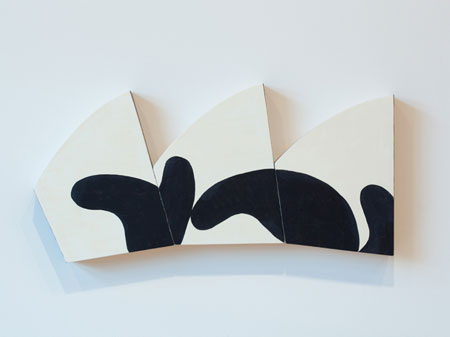
Continuing through January 30, 2012
Around the dinner table one evening in Spring 2010 something creative was on the burner. Eleven female artists sat for supper conversation with Reed College’s Cooley Gallery curator Stephanie Snyder and Lumber Room founder Sarah Miller Meigs. These inter-generational women found an intersection through the power of the belly, opening up in discussion of painting, studio practice and family. Emerging in its wake is a powerful exhibition that suggests with paper (and other assorted surfaces) that Northwest women are operating in full force as well as defying any implied gender-specificity. “Interior Margins” only hints at traditional gestures associated with women’s work. Instead these ladies have otherwise replaced puffy quilting, floral patterns and politico-feminisms with raw imagination and materials.
There are really two shows here. Perhaps this split has been partly influenced by the physicality of the venue. An elegant private loft cum contemporary exhibition space, The Lumber Room features two levels, several rooms and high ceilings of warm honey-colored beams. The dual perspectives offer deep-rooted organics and the morphing primordial body (Kristan Kennedy, Blair Saxon-Hill, Nell Warren) versus ordered systems dispensing complex sacred mathematics (Linda Hutchins, Victoria Haven), symbology (Léonie Guyer) and fractured neo-geometries (Judy Cooke).
Two artists maneuver the in-between of these parenthetical aesthetics: Heather Watkins and Michelle Ross. Watkin’s “Surfacing” (2008-11) groups black on black ink drawings, like fetal pods, emerging right at the very edges of the paper’s border. The installation zig-zags over three adjacent walls in a grid that references the room, punctuated by the asymmetry of one absent corner, the white of the wall itself - perhaps an offering of hope or a nod to the tension of work-in-progress. Two of Ross’ assemblages appear in the main room and one in the lower lobby, and they add the most immediate color to the space with the simple swatch of peek-a-boo pink organza combined with the pop of roughly brushed clementine over a black and white digital print. “A Shallow Metronome” is a nuanced drama that keeps the eye moving to and from a crudely deconstructed fabric remnant. In the entry the artist doesn’t shy from curious stains, frays and other imperfections in “The Mannerist,” a totemic work that puts us face-to-face with a femme fatale the morning after her raucous night of passion.
Sculptural forms add volume throughout the main space. New work by Saxon-Hill is a daring departure and shows off a promising young artist. From a painter who formerly made lovely small-scale landscapes comes a chunky, clunky pair of works that revel in the bold, sooty, lumpy visceralities of industrialized life. “What that Entails and What Comes After” seems on one end to be an homage to Joseph Beuys, sans a blatant riddle. The engaging work in powdery gray, like a cloak hiding something adrift in the cosmos, is assuredly the show’s most poker-faced. In bare contrast are the racy lines of colorful sand embedded through acrylic cubes and tubes by Midori Hirose. Making reference to but unlike Sol Lewitt’s “Incomplete Cubes: from the mid 1970’s, “SQFT” acts as an open cage, an armature of camouflage dipping back into the day-glo fluorescence of the 1980’s, when artists like Stephen Sprouse and Keith Haring reigned. But here by bracketing space the artist doesn’t abandon the fine line for the sake of pomp.
Finally, Kennedy’s “E.G.S.O.E.Y.S.” hangs amid the near visible, elegant shapes of Lynne Woods Turner, writhing from a deep internal space. The thickly layered blackened gesso atop raw canvas recalls early Julian Schnabel. The twist in this five foot six inch tall work is a retrofitting akin to what appears to be a shroud-like breastplate taken from the outside in. In ghostly absentia the work is a comment on painting itself, lost layers of ideas, forever faded from the interior margins.
